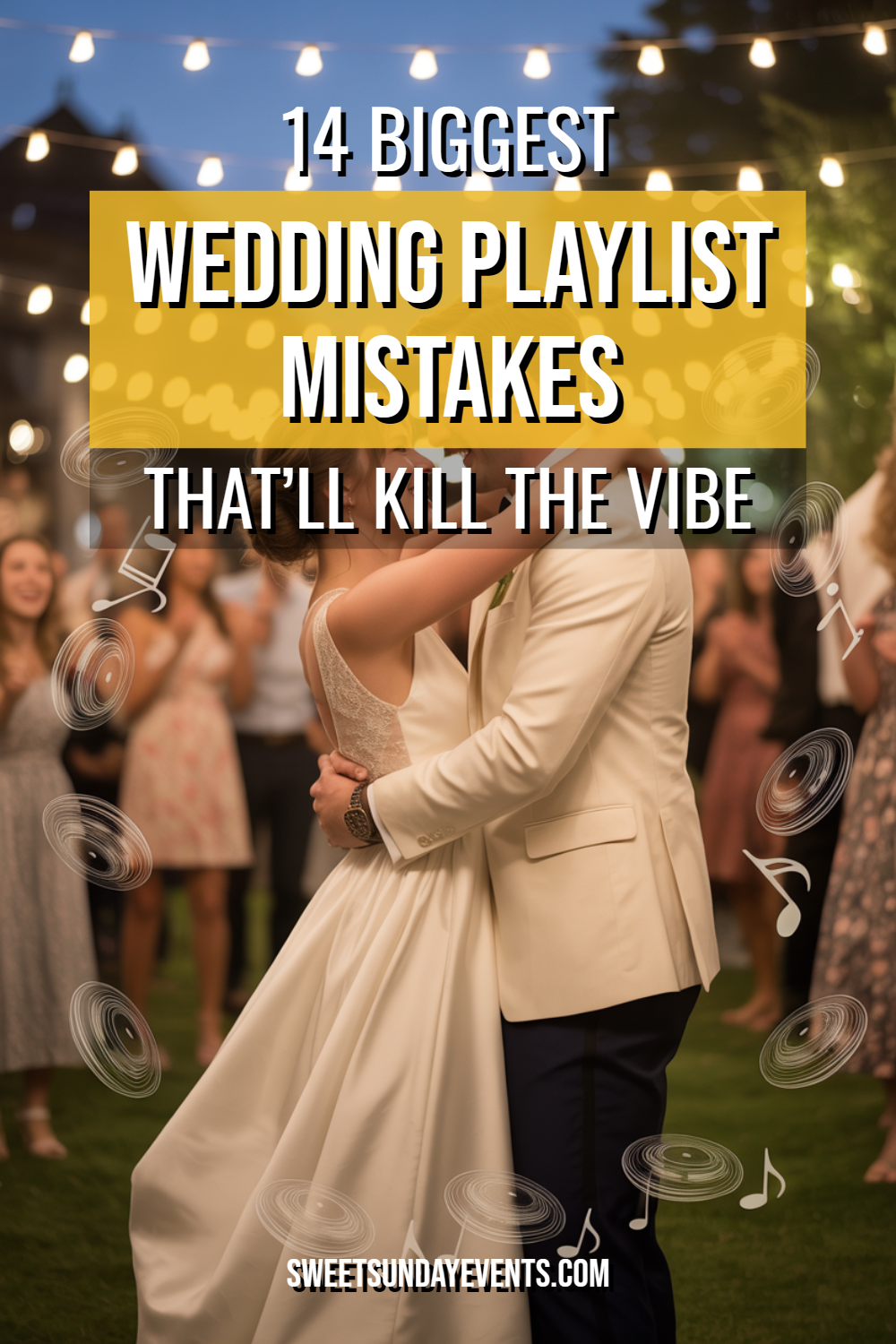Your wedding playlist can make or break your reception. After watching countless couples stress over song choices and witnessing dance floors empty faster than a buffet line, I’ve seen the same playlist mistakes happen over and over again.
Here are the fourteen biggest musical missteps that’ll have your guests heading for the exit instead of the dance floor.
1. Playing Your Entire Music Collection Like It’s Your Personal Concert
Just because you love death metal doesn’t mean Grandma Betty wants to headbang during cocktail hour. Your wedding playlist isn’t the time to showcase your eclectic taste in obscure indie bands or introduce everyone to your favorite Norwegian folk music.
Save the personal deep cuts for moments that matter to you—like your first dance or a special dedication. The rest of your playlist should focus on songs that’ll get the majority of your guests moving, not scratching their heads wondering what they’re listening to.
2. Ignoring Your Guest Demographics Completely
A room full of your college buddies will respond differently than a crowd that’s mostly your parents’ friends from the country club. Look around your guest list and be realistic about what’ll work.
If half your guests are over sixty, throwing in some classics alongside your current favorites will keep everyone happy. The goal is to create moments where different generations can share the dance floor, not divide them into separate corners.
3. Choosing Songs Based on Lyrics Instead of Energy
That beautiful ballad about heartbreak might have gorgeous lyrics, but it’ll kill the momentum faster than a fire drill. Wedding guests don’t always listen to lyrics—they respond to rhythm, energy, and familiarity.
“Somebody That I Used to Know” might be a great song, but it’s literally about a breakup. Meanwhile, “I Want It That Way” by the Backstreet Boys has questionable lyrics but gets everyone singing along because of the melody and nostalgia factor.
4. Creating Awkward Silence Gaps Between Songs
Nothing kills a dance floor vibe like dead air between tracks. When the music stops, people start conversations, grab drinks, or worse—sit down and get comfortable.
Professional DJs know how to seamlessly blend tracks to maintain energy flow. If you’re creating your own playlist, pay attention to song endings and beginnings, and consider using crossfade features to eliminate those momentum-killing pauses.
5. Loading Up on Slow Songs During Peak Dancing Hours
Three slow songs in a row during prime dancing time will clear your floor faster than a tornado warning. Slow songs have their place, but timing is everything.
Use ballads strategically—maybe one every four or five upbeat songs, or save them for specific moments like parent dances or when you want to give people a breather. Your dance floor should feel like a party, not a middle school slow dance.
6. Forgetting About Song Lengths and Letting Tracks Drag On
That eight-minute extended remix of your favorite song will test even your most patient guests. Long songs give people too much time to get bored and wander off.
Stick to radio edits or create custom cuts that keep songs between three to four minutes. If you love a longer song, consider fading it out after the best part instead of letting it play through every instrumental break.
7. Playing Explicit Versions in Front of Great-Aunt Margaret
Your grandmother doesn’t need to hear the uncensored version of “WAP” during dinner service. Explicit lyrics can make guests uncomfortable, especially in mixed company.
Clean versions of popular songs maintain the energy without the awkwardness. Most streaming platforms offer radio edits automatically, but double-check your playlist beforehand to avoid any cringe-worthy moments.
8. Scheduling High-Energy Dance Music During Dinner
Trying to have a conversation over “Uptown Funk” while cutting your chicken is nobody’s idea of a good time. Dinner music should create ambiance, not force people to shout across the table.
Jazz standards, acoustic covers, or mellow indie tracks work perfectly during meal service. Save the dance anthems for when plates are cleared and people are ready to move.
9. Neglecting to Test Your Sound System and Volume Levels
The perfect playlist means nothing if half your guests can’t hear it or if it’s so loud that people can’t talk. Sound issues can derail your entire reception flow.
Test your system with different types of songs at various volumes throughout your venue. What sounds good near the speakers might be too quiet in the back corners, and what’s perfect for slow songs might be overwhelming for high-energy tracks.
10. Relying Too Heavily on Current Top 40 Hits
Today’s chart-toppers might feel dated by your first anniversary. Building your entire playlist around what’s currently popular leaves little room for timeless classics that’ll still sound great years from now.
Mix current hits with proven crowd-pleasers from different decades. Songs like “Don’t Stop Believin'” and “Mr. Brightside” have staying power because they’ve already proven they can get people moving across multiple generations.
11. Forgetting to Plan Backup Songs for Different Scenarios
Your carefully curated playlist might not account for unexpected moments—like when the cake cutting takes longer than expected or when your guests are more (or less) energetic than anticipated. Having backup options ready prevents awkward scrambling.
Create separate mini-playlists for different scenarios: extra cocktail hour music, additional dinner songs, emergency slow songs, and high-energy backup tracks. Flexibility is key when the timeline shifts or the crowd’s energy changes.
12. Ignoring Cultural and Religious Considerations
Not every song that gets the college crowd going will work for your diverse guest list. Some songs might have cultural references that don’t resonate or could potentially offend certain guests.
Consider your guest list’s cultural backgrounds and religious beliefs when selecting tracks. This doesn’t mean sanitizing your playlist completely, but being thoughtful about choices that might alienate important people in your life.
13. Placing Special Songs at the Wrong Moments
That song that reminds you of your first date deserves better placement than randomly thrown into the middle of dancing. Special songs lose their impact when they’re not given proper context.
Plan meaningful songs for specific moments—your entrance, cake cutting, or a surprise dedication. Let your DJ or coordinator know which songs have special significance so they can announce them or time them perfectly.
14. Failing to Have a Designated Music Point Person
Too many cooks in the kitchen leads to playlist chaos. When multiple people are making song requests or trying to control the music, your carefully planned flow goes out the window.
Designate one person (besides yourselves) to handle music decisions during the reception. This could be your DJ, wedding coordinator, or a trusted friend who understands your vision and can make judgment calls when needed.
Final Thoughts on Creating the Perfect Wedding Soundtrack
Your wedding playlist should tell the story of your relationship while keeping your guests entertained. The best wedding music strikes a balance between personal meaning and crowd appeal.
Don’t stress about making it perfect—focus on creating moments where people want to celebrate with you. After all, the most important thing is that you’re surrounded by people you love, dancing to music that makes you happy.


